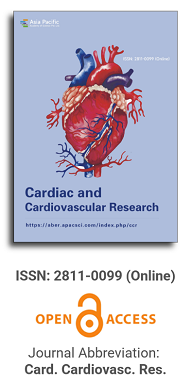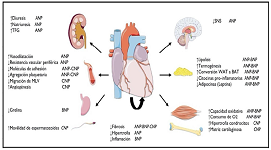
Asia Pacific Academy of Science Pte. Ltd. (APACSCI) specializes in international journal publishing. APACSCI adopts the open access publishing model and provides an important communication bridge for academic groups whose interest fields include engineering, technology, medicine, computer, mathematics, agriculture and forestry, and environment.

Prospect of clinical application of ECG imaging technology
Vol 4, Issue 1, 2023
Download PDF
Abstract
Routine 12 lead ECG is a basic method for clinical evaluation and diagnosis of various cardiovascular diseases. However, due to its low accuracy of ECG mapping, it is seriously limited in the study of potential electrophysiological mechanism of arrhythmia and mapping of origin matrix. The emerging non-invasive ECG imaging technology (ECGI) can reverse reconstruct the spatio-temporal dynamic information of electrophysiological activities at various locations of the heart, explore the occurrence and development mechanism of various arrhythmias, and accurately locate their origin, effectively make up for the lack of traditional mapping technology, and play a very important role in guiding clinical diagnosis and treatment. In recent years, studies at home and abroad have shown that ECGI plays an important role in the diagnosis and treatment of various cardiovascular diseases, such as arrhythmias and cardiac resynchronization therapy. As a non-invasive method, three-dimensional ECGI is a significant progress in conventional ECG mapping, and its great potential to guide clinical diagnosis and treatment needs to be tapped. This article reviews the progress of clinical application of ECGI.
Keywords
References
- China cardiovascular health and disease report compilation group Summary of China cardiovascular health and disease report 2020 Chinese Journal of circulation2021; 36(6): 521–545.
- Cluitmans MJ, Peeters RL, Westra RL, et al. Noninvasive reconstruction of cardiac electrical activity: Update on current methods, applications and challenges. Neth Heart J 2015; 23(6): 301–311.
- Aryana A, O'Neill PG, d'Avila A. Noninvasive electrocardiographic mapping: Are we ready for prime time? J Am Heart Assoc 2015; 4(10): 46–55.
- Tsyganov A, Wissner E, Metzner A, et al. Mapping of ventricular arrhythmias using a novel noninvasive epicardial and endocardial electrophysiology system. J Electrocardiol 2018; 51(1): 92–98.
- Cochet H, Dubois R, Sacher F, et al. Cardiac arrythmias: Multimodal assessment integrating body surface ECG mapping into cardiac imaging. Radiology 2014; 271(1): 239–247.
- Cakulev I, Sahadevan J, Arruda M, et al. Confirmation of novel noninvasive high-density electrocardiographic mapping with electrophysiology study: Implications for therapy. Circ Arrhythm Electrophysiol 2013; 6(1): 68–75.
- Pereira H, Niederer S, Rinaldi CA. Electrocardiographic imaging for cardiac arrhythmias and resynchronization therapy. Europace 2020; 22(10): 1447–1462.
- Ban JE, Park HC, Park JS, et al. Electrocardiographic and electrophysiological characteristics of premature ventricular complexes associated with left ventricular dysfunction in patients without structural heart disease. Europace, 2013; 15(5): 735–741.
- Cluitmans M, Brooks DH, macleod R, et al. Validation and opportunities of electrocardiographic imaging: From technical achievements to clinical applications. Front Physiol 2018; 9: 1305–1316.
- Jamil-Copley S, Bokan R, Kojodjojo P, et al. Noninvasive elec-trocardiographic mapping to guide ablation of outflow tract ventricular arrhythmias. Heart Rhythm 2014; 11(4): 587–594.
- Erkapic D, Greiss H, Pajitnev D, et al. Clinical impact of a novel three-dimensional electrocardiographic imaging for non-invasive mapping of ventricular arrhythmias-a prospective randomized trial[J]. Europace 2015; 17 (4): 591–597.
- Zhou X, Fang L, Wang Z, et al. Comparative analysis of electrocardiographic imaging and ECG in predicting the origin of outflow tract ventricular arrhythmias. J Int Med Res 2020; 48(3): 135–142.
- Wang L, Gharbia OA, Horacek BM, et al. Noninvasive epicardial and endocardial electrocardiographic imaging of scar-related ventricular tachycardia. J Electrocardiol 2016; 49(6): 887–893.
- Cuculich PS, Zhang J, Wang Y, et al. The electrophysiological cardiac ventricular substrate in patients after myocardial infarction: Noninvasive characterization with electrocardiographic imaging. J Am Coll Cardiol 2011; 58 (18): 1893–1902.
- Haissaguerre M, Hocini M, Cheniti G, et al. Localized structural alterations underlying a subset of unexplained sudden cardiac death. Circ Arrhythm Electrophysiol 2018; 11(7): 106–120.
- Frontera A, Cheniti G, Martin C, et al. Frontiers in non-invasive cardiac mapping: Future implications for arrhythmia treatment. Minerva cardioangiologica 2018; 66(1): 75–82.
- Shah AJ, Hocini M, Xhaet O, et al. Validation of novel 3-dimensional electrocardiographic mapping of atrial tachycardias by invasive mapping and ablation: A multicenter study. J Am Coll Cardio 2013; 62(10): 889–897.
- Wang Y, Cuculich P, Woodard P, et al. Focal atrial tachycardia after pulmonary vein isolation: Noninvasive mapping with electrocardiographic imaging (ECGI). Heart Rhythm 2007; 4(8): 1081–1084.
- Pedron-Torrecilla J, Rodrigo M, Climent AM, et al. Noninvasive estimation of epicardial dominant high-frequency regions during atrial fibrillation. J Cardiovasc Electrophysiol 2016; 27(4):435–442.
- Cuculich PS, Wang Y, Lindsay BD, et al. Noninvasive characterization of epicardial activation in humans with diverse atrial fibrillation patterns. Circulation 2010; 122(14): 1364–1372.
- Haissaguerre M, Hocini M, Denis A, et al. Driver domains in persistent atrial fibrillation. Circulation 2014; 130(7): 530–538.
- Cheniti G, Puyo S, Martin CA, et al. Noninvasive mapping and electrocardiographic imaging in atrial and ventricular arrhythmias(cardioinsight). Card Electrophysiol Clin 2019; 11(3): 459–471.
- Strik M, Ploux S, Jankelson L, et al. Non-invasive cardiac mapping for non-response in cardiac resynchronization therapy. Annmed 2019; 51(2): 109–117.
- Sieniewicz BJ, Jackson T, Claridge S, et al. Optimization of CRT programming using non-invasive electrocardiographic imaging to assess the acute electrical effects of multipoint pacing. J Arrhythm 2019; 35(2): 267–275.
- Bear LR, Huntjens PR, Walton RD, et al. Cardiac electrical dyssynchrony is accurately detected by noninvasive electrocardiographic imaging. Heart Rhythm 2018; 15(7): 1058–1069.
- Silva JN, Ghosh S, Bowman TM, et al. Cardiac resynchronization therapy in pediatric congenital heart disease: Insights from noninvasive electrocardiographic imaging. Heart Rhythm 2009; 6(8): 1178–1185.
- Revishvili AS, Wissner E, Lebedev DS, et al. Validation of the mapping accuracy of a novel non-invasive epicardial and endocardial electrophysiology system. Europace 2015; 17(8): 1282–1288.
- Ploux S, Lumens J, Whinnett Z, et al. Noninvasive electrocardiographic mapping to improve patient selection for cardiac resynchronization therapy: Beyond QRS duration and left bundle branch block morphology. J Am Coll Cardiol 2013; 61(24): 2435–2443.
- Zweerink A, Zubarev S, Bakelants E, et al. His-optimized cardiac resynchronization therapy with ventricular fusion pacing for electrical resynchronization in heart failure. JACC Clin Electrophysiol 2021; 7(7): 881–892.
- Berger T, Pfeifer B, Hanser FF, et al. Single-beat noninvasive imaging of ventricular endocardial and epicardial activation in patients undergoing CRT. Plos One 2011; 6 (1): 248–255.
- Vijayakumar R, Silva JN, Desouza KA, et al. Electrophysiologic substrate in congenital long QT syndrome: Noninvasive mapping with electrocardiographic imaging (ECGI). Circulation 2014; 130(22): 1936–1943.
- Galli A, Rizzo A, Monaco C, et al. Electrocardiographic imaging of the arrhythmogenic substrate of Brugada syndrome: Current evi-dence and future perspectives. Trends Cardiovasc Med 2020; 31(5): 323–329.
- Zhang J, Sacher F, Hoffmayer K, et al. Cardiac electrophysiological substrate underlying the ECG phenotype and electrogram abnormalities in Brugada syndrome patients. Circulation 2015; 131 (22): 1950–1959.
- Cakulev I, Sahadevan J, Waldo AL. Noninvasive diagnostic mapping of supraventricular arrhythmias (Wolf-Parkinson-White syndrome and atrial arrhythmias). Card Electrophysiol Clin 2015; 7(1): 79–88.
- Berger T, Fischer G, Pfeifer B, et al. Single-beat noninvasive imaging of cardiac electrophysiology of ventricular pre-excitation. J Am Coll Cardiol 2006; 48(10): 2045–2052.
- Nademanee K, Veerakul G, Chandanamattha P, et al. Prevention of ventricular fibrillation episodes in Brugada syndrome by catheter ablation over the anterior right ventricular outflow tract epicardium. Circulation 2011; 123(12): 1270–1279.
- Nademanee K, Hocini M, Haissaguerre M. Epicardial substrate ablation for Brugada syndrome. Heart Rhythm 2017; 14 (3): 457–461.
- Seger M, Fischer G, Modre R, et al. Lead field computation for the electrocardiographic inverse problem-finite elements versus boun-dary elements. Comput Methods Programs Biomed, 20.05, 77(3): 241–252.
- Lin F, Qi Z, Wei M, et al. TV regularized low-rank framework for localizing premature ventricular contraction origin. IEEE Access 2019; 7: 27802–27813.
Supporting Agencies
Copyright (c) 2023 Yang Lou, Xinbin Zhou, Wei Mao

This work is licensed under a Creative Commons Attribution 4.0 International License.

This site is licensed under a Creative Commons Attribution 4.0 International License (CC BY 4.0).

Prof. Prakash Deedwania
University of California,
San Francisco, United States




